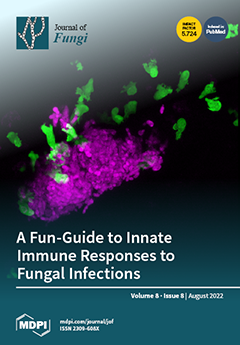Forcipomyia taiwana (Diptera: Ceratopogonidae) is a nuisance blood-sucking pest to humans in Taiwan. An
F. taiwana bite causes itching and redness and usually causes serious harassment to human outdoor activity. In terms of
F. taiwana control, chemical pesticides are ineffective. Therefore, other efforts
[...] Read more.
Forcipomyia taiwana (Diptera: Ceratopogonidae) is a nuisance blood-sucking pest to humans in Taiwan. An
F. taiwana bite causes itching and redness and usually causes serious harassment to human outdoor activity. In terms of
F. taiwana control, chemical pesticides are ineffective. Therefore, other efforts are needed. Fungal mycosis in the larvae, pupae, and emerging
F. taiwana adults was found during the rearing of
F. taiwana. In this study, six fungal isolates were isolated from infected cadavers and subjected to molecular identification. In addition, their biocontrol potential was evaluated against different life stages of
F. taiwana. Based on the pathogenicity screening, two fungal isolates, NCHU-NPUST-175 and -178, which caused higher mortality on the fourth instar larvae of
F. taiwana, were selected for virulence tests against different life stages of
F. taiwana larvae. The results of the phylogenetic analysis indicated that the NCHU-NPUST-175 and -178 belonged to
Purpureocillium lilacinum and
Fusarium verticillioides, respectively. Bioassay against different life stages of
F. taiwana with different spore concentrations (5 × 10
5 to 5 × 10
7 conidia/mL) revealed a dose-dependent effect on larvae for both fungal isolates, while only 38% and 50% mortality was found in highest concentration (5 × 10
7 conidia/mL) at fourth instar larvae by Pl-NCHU-NPUST-175 and Fv-NCHU-NPUST-178, respectively. Moreover, reductions in egg-hatching rate and adult emergence rate were found, when the last stage of
F. taiwana was inoculated with both fungal isolates, indicating the ovicidal potential and the impact of entomopathogenic fungi on the development of
F. taiwana. In conclusion, Pl-NCHU-NPUST-175 and Fv-NCHU-NPUST-178 showed larvicidal activity, ovicidal activity, and impact on adult emergence on
F. taiwana.
Full article






